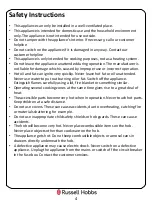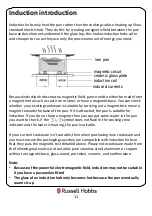
Induction introduction
Induction hobs only heat the pan rather than the cooking surface heating up like a
standard electric hob. They do this by creating a magnetic field between the pan
base and an element underneath the glass top; this makes induction hobs safer
and cheaper to run as they use only the precise amount of energy you need.
Because induction hobs create a magnetic field, pans need to either be made from
a magnet metal such as cast iron or steel, or have a magnetic base. You can check
whether your existing cookware is suitable by carrying out a magnet test: move a
magnet towards the base of the pan. If it is attracted, the pan is suitable for
induction. If you do not have a magnet then you can put some water in the pan
you want to check, if the symbol does not flash in the cooking zone
indicator and the water is heating, the pan is suitable.
If your current cookware isn’t suitable, then when purchasing new cookware and
you must ensure the packaging says they are compatible with induction hobs or
that they pass the magnetic test detailed above. Please note cookware made from
the following materials is not suitable: pure stainless steel, aluminum or copper
without a magnetic base, glass, wood, porcelain, ceramic, and earthenware.
Note:
•
Because of the powerful electromagnetic field, induction may not be suitable
if you have a pacemaker fitted
•
The glass of an induction hob only becomes hot because the pan eventually
warms it up
11
iron pan
magnetic circuit
ceramic glass plate
induction coil
induced currents
Summary of Contents for RH60IH401B
Page 31: ...31 Notes ...












































